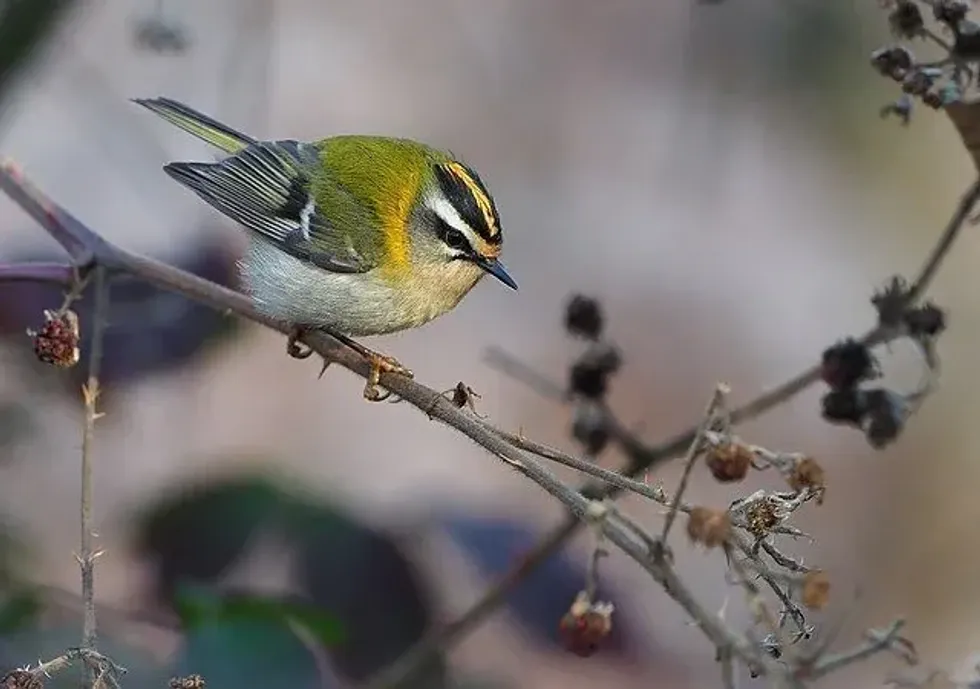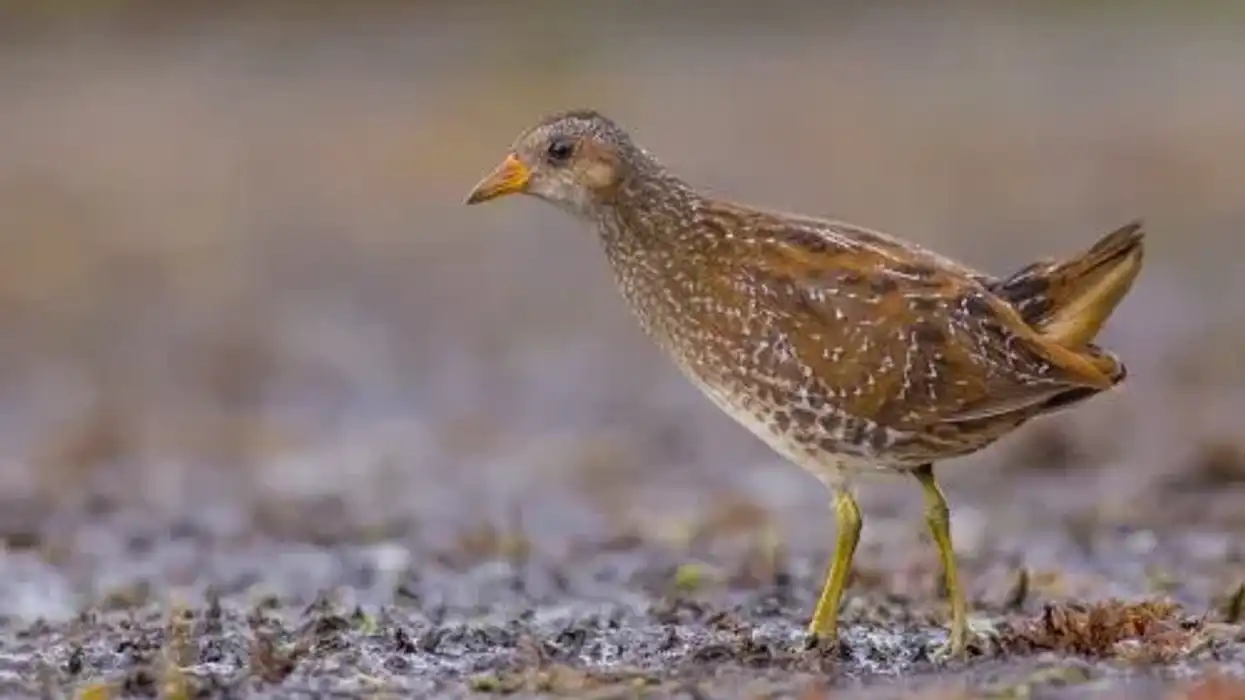Are you fond of tiny birds like the golden-crowned kinglet? If yes, then you would definitely find the common firecrest charming.
This bird is found in various parts of Europe, North America, and Asia minor. However, this yellow-black bird has a special place in South England where it is especially seen in the breeding season. The bird has a good population distribution and it belongs to the family Regulidae.
The scientific name of this bird is Regulus ignicapilla. As it's a very small bird, you will be hardly able to see it, but you can hear the song which is high-pitched and is repeated. However, its song is less high-pitched than that of goldcrest.
This bird mainly feeds on insects, and it often tends to catch big spiders. It may be found wintering in the south and west of Europe.
Want to know more about this bird that's well-loved in England? Keep reading for interesting common firecrest facts. Also, check out the articles on the dartford warbler and sooty shearwater for interesting information about birds.
Common Firecrest Interesting Facts
What type of animal is a common firecrest?
The common firecrest (Regulus ignicapilla) is a small bird from the order Passeriformes, which is known for a bright orange feather crown present on the head of male birds. The beautiful mountain bluebird also belongs to the same order.
What class of animal does a common firecrest belong to?
The common firecrest (Regulus ignicapilla) belongs to the class Aves, and to the genus Regulus.
How many common firecrests are there in the world?
The common firecrests are commonly found Passeriformes, so we don't really know about their population distribution.
Where does a common firecrest live?
The common firecrest (Regulus ignicapilla) is found in different parts of Europe, North Africa, and in Asia minor in areas like the Balearic Islands, Crimea, and Western Caucasus. As it's common in many places we cannot call it endemic to a specific area.
What is a common firecrest's habitat?
The common firecrests are found in coniferous woodland habitats especially on trees like spruce, fir, cork oak, holy oak, and on other trees. These birds are also found in mixed forests and deciduous stands. In Morocco, the birds can be seen on Atlantic cedar trees.
Who do common firecrests live with?
The common firecrest may live in flocks and it is also a primary migratory bird, so every year it flies to places before the breeding season. A lot of the birds flies to the Iberian Peninsula and to South-East Europe.
Some populations also travel to the coasts of Belgium and the Netherlands. Southern England is an especially favorite place and breeding ground for this species and it visits a lot of gardens.
How long does a common firecrest live?
These small birds have a short lifespan range which can be fewer than two years.
How do they reproduce?
One of the most interesting things about the species is its breeding. The season lasts between April and August and these birds produce around two broods every year. Things like moss, lichen, spider webs and feathers are used to line the nest.
These small birds can have a clutch range of around 6-13 eggs. However, the number of eggs can go down in the second clutch.
Nests have been seen in coniferous trees, climbing ivy plants, and deciduous trees. The female birds take care of incubating the eggs and males take care of feeding the female bright foods. The incubation period may last for up to 15 days, and the chicks take another 14-15 days to leave the nests.
What is their conservation status?
According to the International Union for Conservation of Nature (IUCN) Red List, the common firecrest is currently classified under the status of Least Concern.
Common Firecrest Fun Facts
What do common firecrests look like?
When it comes to this tiny bird, you can mostly recognize it through the yellow feathers. However, on a closer look at the common firecrest, you will see the black and white highlights along with the details present on its head.
To begin with, it has been named firecrest because of the bright orange-red crown present in the male birds. This tuft meets the yellow feathers on its back and you can see more black and pale orange patches on its forehead.
The wings of this bird have a greenish-yellow or black color and it is streaked by two white wing bars. The needle-like thin bill of this species is black while the feet are peach pink or light orange.
Its belly and the undersides of its wings are white. Apart from the lack of a crown, males and females don't look very different.
Even juveniles also have a similar physical description except that their plumage is considerably paler. This bird's look has been described to be similar to that of the warblers.

How cute are they?
This tiny bird is quite cute, just like the palm warblers and the common firecrest is said to be smaller than most warblers.
How do they communicate?
As a small bird, we can say that this bird has pretty loud calls that sound like 'zit-zit-zit' as well as the 'si si si see see see seeeh seeeh' calls. An individual bird may person up to five different calls and its song might be linked to the breeding season.
When being territorial, this bird can also make whistling calls.
How big is a common firecrest?
The average body size range of this bird is around 3.5 in (9 cm) making it quite small. Compared to it, the ruby-crowned kinglets have a body size range of around 3.5-4.3 in (9-11 cm).
How fast can a common firecrest fly?
We are yet to get any data about the flight speed of this bird, but it is known to fly around the trees of woodland. However, we do know that this plump bird has a wingspan of around 5.1–6.3 in (13–16 cm).
How much does a common firecrest weigh?
The average body weight range of this bird is around 0.1-0.2 oz (2-5.66 g). So, they cannot be considered very heavy.
What are the male and female names of the species?
There are no specific names for the male and female of the common firecrest species.
What would you call a baby common firecrest?
The baby common firecrest (Regulus ignicapilla) is known as a chick.
What do they eat?
These small birds mainly feed on arthropods and insects. Favorite food items for the birds include moths, caterpillars, aphids, and spiders. These birds like to hunt for large prey usually on the tree branches and under the canopy.
Once it has got prey you can see the birds munching on it sitting on the tree. During the breeding season, you can catch large flocks of this species hunting for food. However, in the non-breeding season, you will find thin flocks or mixed-species flocks.
Are they dangerous?
No, this sweet little tiny bird is far from being dangerous to anyone. However, be aware that you wouldn't want to irritate it as pecking from its small bill can hurt a lot.
Would they make a good pet?
No, this is a wild bird that wouldn't be able to survive in a home environment. However, the best thing about this species is that you can often find flocks of these birds roaming in gardens. This phenomenon mainly happens during wintering when it wanders into urban areas for food.
Did you know...
The two known subspecies of this bird are Regulus ignicapilla ignicapilla (found in Europe and Asia minor) and Regulus ignicapilla balearicus (found on the Balearic Island and North Africa.)
What is the difference between a goldcrest and firecrest?
The goldcrest and the common firecrest (Regulus ignicapilla) birds may look very similar, but the difference lies mainly in the supercilium of the firecrest which is a white patch seen on top of its head. Moreover, the firecrest has a black stripe present through each of its eyes which is missing in the goldcrests.
Also, the goldcrest species tend to be smaller than the firecrests and it has also got the title of being the smallest bird present in Britain.
How do you spot a firecrest?
The common firecrest (Regulus ignicapilla) is a small bird and you can spot it in the spruce or fir trees of coniferous woodland. However, to identify this tiny bird you can look for the orange crest or tuft of feathers present on the male bird's head which turns into a pale orange patch in the lower forehead.
You can identify a female through the eye stripe that is especially seen in this bird species.
Here at Kidadl, we have carefully created lots of interesting family-friendly animal facts for everyone to discover! For more relatable content, check out these common raven facts and North Island brown kiwi facts pages.
You can even occupy yourself at home by coloring in one of our free printable bird of paradise advanced Coloring Pages.
Main image by Frank Vassen and second image by Juan Lacruz.










